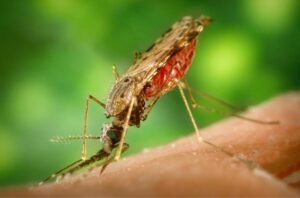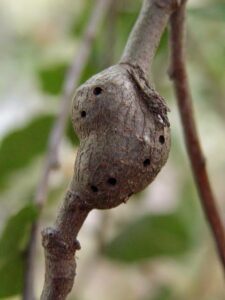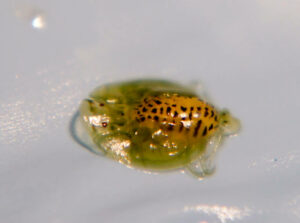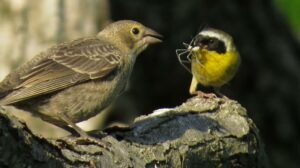Parasitism is a relationship between two species in which one individual lives on the other (host) one, absorbs nutrients or necessary materials from it and causes harm to it. Let’s discuss some most common parasitism examples.
Here we mention 25 most common parasitism examples, such as-
Let’s have a closer look at the following parasitism examples-
Malaria
Malaria is a disease caused by a parasitic microorganism called Plasmodium. It is transferred to the human body with the help of a vector female anopheles mosquito. After being introduced into the human body the parasites travel through the blood to the liver and live there. It causes malaria disease in the human body.

Maleria from Pixabay.com
Fasciolosis
Fasciolosis is another one of the most common parasitism examples. A group of microorganisms called liver fluke cause this disease in the host body. Fasciola hepatica is a parasitic worm that infects ruminants like sheep, cattle, etc and causes fasciolosis. It can also infect human hosts rarely.
Ascariasis
Ascariasis is a disease caused by a parasitic nematode species Ascaris. It infects human hosts generally. The species Ascaris Lumbricoides is the most popular human parasitic species under the genus. An infected individual increases parasitic eggs through the faces in soil and when another one consumes some plant materials and the attached parasitic eggs, that person gets infected.
Taeniasis
Taeniasis is parasitism caused by Platyhelminthes species Taenia solium. In this disease, the Taenia species infect the intestine host. The infection lasts for up to two to three years in an individual. It can cause severe medical conditions in the human body.
Hookworm infection
Hookworm refers to a group of parasitic species typically belonging to the genera Ancylostoma. There are blood-feeding parasites that generally infect human hosts. Ancylostoma duodenale is one of the most common hookworms which infect humans as their primary host.
Diphyllobothriasis
Diphyllobothriasis is one of the most common parasitism examples. A common tapeworm species Diphyllobothrium causes this infection in the human body. As a result of consuming raw fish regularly the parasite infects the human body and causes diphyllobothriasis. In this disease B12 deficiency and gastrointestinal obstructions, fatigue may happen.
Leech
Leech is a parasitic worm belonging to subclass Hirudinea. These worms generally attach themselves with their suckurs to their host body and suck blood from them. Most of the leeches choose invertebrates or lower vertebrates as their host. Ozobranchus is one of the common leech species that shows parasitism with turtles and Piscicolidae is also a leech that shows parasitism with fishes.

Leech from Wikimedia commons
Scabies
Scabies is also one of the most common parasitism examples. A parasitic mite species called Sarcoptes scabiei caused the disease. The parasite mostly infects mammalian species including dogs, cats, ungulates, bovids, koalas and also humans.
Body Lice
Body Lice or body louse are parasitic insects which feed on the blood of humans as an ectoparasite. The species Pediculus humanus humanus do not directly live on the host body; they stay mostly on the clothing and come in contact only for the purpose of feeding.
Head lice
Head lice or head louse are one of the most common parasitism examples. They infect human hosts and live as ectoparasites on the scalp. They are slightly different from the body louse. The head louse generally lay eggs on the hair of their hosts and sucks blood from the scalp.
Flea
Flea is arthropod ectoparasites primarily infecting mammalian species including dogs, cats, etc. Humans can also be parasitized by them. It is one of the most common parasitism examples. Which causes a skin disease called Pulicosis. Pets can also develop flea allergy dermatitis by increasing levels of infection.
Aphids
The relationship between aphids and trees is another one of the most common parasitism examples. In this relationship, the aphids, sap-suking worms infect several plant species and harm them intensely.
Galls
Galls are a kind of disease or more specifically say swelling at the outer tissues of plant species caused by gall wasps. Different mites, viruses, and fungi can cause gall or plant tumours which are very harmful to the host species.

Galls from Wikimedia commons
Haustorium of Mistletoe
In plant species, haustorium of Mistletoe is one of the most common parasitism examples. In which mistletoe parasitic species develop a rootlike structure on the host Plant species through which it absorbs nutrients and water.
Giardiasis
Giardiasis is one of the most common parasitism examples. In this disease, the parasite Giardia duodenalis infects human hosts. An infected individual may experience diarrhoea, abdominal pain, and weight loss due to giardiasis.
Toxascaris
Toxascaris is a parasitic helminth belonging to the phylum Nematoda. This species is parasitic on mammals including dogs, cats, foxes, mice, rats, etc. Humans are not generally infected by them.
Toxoplasmosis
Toxoplasmosis is a parasitic disease caused by parasite Toxoplasma gondii. It generally infects domestic cats. By eating undercooked meat containing Toxoplasma eggs or contact with the cat’s litter box can also be the reason for toxoplasma infection in humans.
Amoebiasis
Amoebiasis is a parasitic disease caused by the infection of protozoan parasite Entamoeba histolytica. It is very harmful to their hosts, having the ability to kill them also. Its primary hosts are humans and other primates.
Enterobiasis
Enterobiasis is a parasitic disease caused by an helminth parasite Enterobius vermicularis. It primarily infects humans as well as other primates including Orangutans, chimpanzees, etc. The main symptom of this infection is itching in the anal area of body.
Lymphatic filariasis
lymphatic filariasis is another one of the most common parasitism examples. It is caused by the nematode parasite Wuchereria bancrofti. Different mosquito species spread Wuchereria infection. The mosquitos are the intermediate host and humans are the definitive hosts of the Wuchereria parasite.
Coccidiosis
A parasitic worm Coccidia can develop the disease Coccidiosis in their host body. It infects human hosts and damages intestinal cells. As a result bloody, watery diarrhea, dehydration is seen.
Gapeworm
Gapeworm is an parasitic worm species primarily infects poultry bird species like chickens, turkeys, etc. It lives on the host’s trachea and lays eggs into it. The infection increases the mortality rate of the hosts by nearly 25% and rapidly spreads among other species.
Cymothoa exigua
Cymothoa exigua is a parasitic louse which infects fish species. It enters through the gill of the fish then gradually attacks the tongue of the host fish. After cutting off the tongue the parasite attaches on that side. It is also known as tongue-eating louse.
Gyrodactylus salaris
Gyrodactylus salaris is generally known as salmon fluke, one of the most common parasitism examples. It infects salmon fish and attaches them. Simultaneously releasing proteolytic enzymes the parasite dissolves the skin of the fish and sucks it.
Carp lice
Carp lice or Argulus is a parasitic louse that infects fish carp species. In this case the lice live on the skin of the carp host and feed on the mucous and skin cells of it. Adult parasites feed on the blood of the host from fins.

Carp lice or Argulus from Flickr.com
These are some very common parasitism examples in which the parasitic species lives on or inside the body of its host, depands on it for nutrition and on the other hand harm the host species as a typical parasite.
Parasitism examples in plants
In the environment we can see different kinds of parasitism examples in plant species.
Aphids are parasitic insects which sucks nutrients from a host plant. Gall wasps are another plant parasite which develops swelling or gall in the outer tissues of the plant and sucks nutrients. Mistletoe, Cuscuta, Rafflesia arnoldii are parasitic plants which suck water, nutrients from host tree and use them to climb up.
Parasitism examples in the ocean
Just like the land environment, we can see parasitism examples in oceans also.
Cymothoa exigua is found in the ocean which eats the tongue of the host fish and lives in that place. Sacculina barnacle is a marine parasite which lives on crab hosts and manipulates their behavior. Placentonema gigantissima is the world’s largest nematode endoparasite which lives in the uterus or placenta of sperm whales.
Brood parasitism examples
Brood parasitism is a type of breeding strategy in which the young offspring (parasites) depend on the host species to raise them and give parental care to them.
Brood parasitism is mostly found in bird species. In case of indigobirds, whydahs, Cuckoos, black-headed ducks, interspecific brood parasitism is found. In case of Mochokidae catfishes brood parasitism is found. Some brood parasite insects are found including Polistes sulcifer which depends on the host species to raise the offspring.

Brood parasitism examples from Wikimedia commons
Desert parasitism examples
Parasitism is also seen in desert environments.
Mistletoe is a parasitic plant found in the desert areas. It depends on its host plant for nutrition. It creates a structure made up of plant tissues called haustorium, through which it absorbs water and nutrients from the host plant. Dodders or Cuscuta is another parasitic plant found in desert environments.
As a whole we can say that parasitism is one of the most common relationships between two species in nature. There are several kinds of parasites found in different parts of the world. Here we mention some most common Parasitism examples. Hope this article on parasitism will be helpful to you.
Also Read:
- Is fungi multicellular or unicellular
- Chemiosmosis in chloroplasts
- Channel protein function
- Is coenzyme an enzyme
- Are bacteria intracellular
- Protein synthesis process
- Do chloroplasts have a nucleus
- Dna replication steps 2
- Femur anatomy
- Do bacteria have mitochondria

Hello, I am Piyali Das, pursuing my Post Graduation in Zoology from Calcutta University. I am very passionate on Academic Article writing. My aim is to explain complex things in simple way through my writings for the readers.